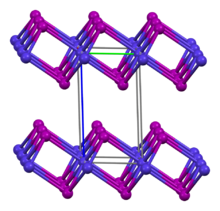Chemistry:Cobalt(II) iodide

| |
| Names | |
|---|---|
| IUPAC name
Cobalt(II) iodide
| |
| Other names
cobaltous iodide, cobalt diiodide
| |
| Identifiers | |
| |
3D model (JSmol)
|
|
| ChemSpider | |
| EC Number |
|
PubChem CID
|
|
| UNII | |
| |
| |
| Properties | |
| CoI2 | |
| Molar mass | 312.7421 g/mol (anhydrous) 420.83 g/mol (hexahydrate) |
| Appearance | α-form: black hexagonal crystal β-form: yellow powder |
| Density | α-form: 5.584 g/cm3 β-form: 5.45 g/cm3 hexahydrate: 2.79 g/cm3 |
| Melting point | α-form: 515-520 °C under vacuum β-form: converts to α-form at 400 °C |
| Boiling point | 570 °C (1,058 °F; 843 K) |
| 67.0 g/100 mL[1] | |
| +10,760·10−6 cm3/mol | |
| Hazards | |
| GHS pictograms |  
|
| GHS Signal word | Warning |
| H302, H312, H315, H319, H332, H335 | |
| NFPA 704 (fire diamond) | |
| Related compounds | |
Other anions
|
Cobalt(II) fluoride Cobalt(II) chloride Cobalt(II) bromide |
Other cations
|
Nickel(II) iodide Copper(I) iodide |
Except where otherwise noted, data are given for materials in their standard state (at 25 °C [77 °F], 100 kPa). | |
| Infobox references | |
Cobalt(II) iodide or cobaltous iodide are the inorganic compounds with the formula CoI2 and the hexahydrate CoI2(H2O)6. These salts are the principal iodides of cobalt.[2]
Synthesis
Cobalt(II) iodide is prepared by treating cobalt powder with gaseous hydrogen iodide.[2] The hydrated form CoI2.6H2O can be prepared by the reaction of cobalt(II) oxide (or related cobalt compounds) with hydroiodic acid.
Cobalt(II) iodide crystallizes in two polymorphs, the α- and β-forms. The α-polymorph consists of black hexagonal crystals, which turn dark green when exposed to air. Under a vacuum at 500 °C, samples of α-CoI2 sublime, yielding the β-polymorph as a yellow crystals. β-CoI2 also readily absorbs moisture from the air, converting into green hydrate. At 400 °C, β-CoI2 reverts to the α-form.[2]
Structures
The anhydrous salts adopt the cadmium halide structures.
The hexaaquo salt consists of separated [Co(H2O)6]2+ and iodide ions as verified crystallographically.[3][4]
Reactions and applications
Anhydrous cobalt(II) iodide is sometimes used to test for the presence of water in various solvents.[5]
Cobalt(II) iodide is used as a catalyst, e.g. in carbonylations. It catalyzes the reaction of diketene with Grignard reagents, useful for the synthesis of terpenoids[6]
References
- ↑ Perry, Dale L.; Phillips, Sidney L. (1995), Handbook of Inorganic Compounds, CRC Press, pp. 127–8, ISBN 0-8493-8671-3, https://books.google.com/books?id=0fT4wfhF1AsC&q=%22Cobalt(II)+iodide%22&pg=PA128, retrieved 2008-06-03
- ↑ 2.0 2.1 2.2 O. Glemser "Cobalt, Nickel" in Handbook of Preparative Inorganic Chemistry, 2nd Ed. Edited by G. Brauer, Academic Press, 1963, NY. Vol. 1. p. 1518.
- ↑ “Structure Cristalline et Expansion Thermique de L’Iodure de Nickel Hexahydrate“ (Crystal structure and thermal expansion of nickel(II) iodide hexahydrate) Louër, Michele; Grandjean, Daniel; Weigel, Dominique Journal of Solid State Chemistry (1973), 7(2), 222-8. doi: 10.1016/0022-4596(73)90157-6
- ↑ "The crystal structure of the crystalline hydrates of transition metal salts. The structure of CoI2·6H2O" Shchukarev, S. A.; Stroganov, E. V.; Andreev, S. N.; Purvinskii, O. F. Zhurnal Strukturnoi Khimii 1963, vol. 4, pp. 63-6.<!no doi in CAS-->
- ↑ Armarego, Wilfred L. F.; Chai, Christina L. L. (2003), Purification of Laboratory Chemicals, Butterworth-Heinemann, pp. 26, ISBN 0-7506-7571-3, https://books.google.com/books?id=SYzm1tx2z3QC&q=%22Cobalt(II)+iodide%22&pg=PA26, retrieved 2008-06-03
- ↑ Agreda, V. H.; Zoeller, Joseph R. (1992), Acetic Acid and Its Derivatives, CRC Press, pp. 74, ISBN 0-8247-8792-7, https://books.google.com/books?id=3MjdGp1v1YIC&q=%22Cobalt(II)+iodide%22&pg=RA1-PA784, retrieved 2008-06-03
| HI | He | ||||||||||||||||
| LiI | BeI2 | BI3 | CI4 | NI3 | I2O4, I2O5, I4O9 |
IF, IF3, IF5, IF7 |
Ne | ||||||||||
| NaI | MgI2 | AlI3 | SiI4 | PI3, P2I4 |
S | ICl, ICl3 |
Ar | ||||||||||
| KI | CaI2 | Sc | TiI4 | VI3 | CrI3 | MnI2 | FeI2 | CoI2 | NiI2 | CuI | ZnI2 | Ga2I6 | GeI2, GeI4 |
AsI3 | Se | IBr | Kr |
| RbI | SrI2 | YI3 | ZrI4 | NbI5 | Mo | Tc | Ru | Rh | Pd | AgI | CdI2 | InI3 | SnI4, SnI2 |
SbI3 | TeI4 | I | Xe |
| CsI | BaI2 | HfI4 | TaI5 | W | Re | Os | Ir | Pt | AuI | Hg2I2, HgI2 |
TlI | PbI2 | BiI3 | Po | AtI | Rn | |
| Fr | RaI2 | Rf | Db | Sg | Bh | Hs | Mt | Ds | Rg | Cn | Nh | Fl | Mc | Lv | Ts | Og | |
| ↓ | |||||||||||||||||
| La | Ce | Pr | Nd | Pm | SmI2 | Eu | Gd | TbI3 | Dy | Ho | Er | Tm | Yb | Lu | |||
| Ac | ThI4 | Pa | UI3, UI4 |
Np | Pu | Am | Cm | Bk | Cf | EsI3 | Fm | Md | No | Lr | |||
 |


